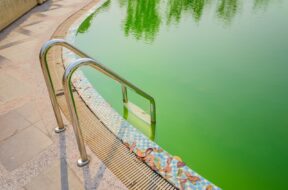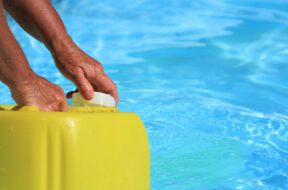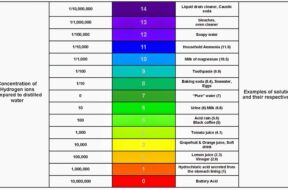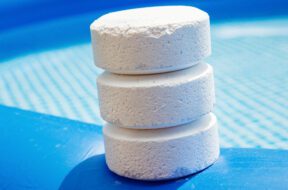
Want to learn more about algaecide? Read on to find out when to add algaecide to your pool maintenance routine and other helpful tips.
There are three types of pool stabilizer: stabilized chlorine, liquid stabilizer, and granular stabilizer. Which type of stabilizer you should use is largely a matter of personal preference.
Stabilized chlorine is the easiest way to add stabilizer to your pool. Stabilized chlorine is a chlorine solution that already integrates cyanuric acid with the chlorine molecules to keep free chlorine from being lost due to photolysis. To learn more, check out The Relationship Between Swimming Pool Chlorine and Cyanuric Acid.
The benefit of using stabilized chlorine that simultaneously adds stabilizer to your pool water is convenience. By adding stabilized chlorine, you will not have to worry about your free chlorine levels plummeting in direct sunlight. You will also likely not have to adjust your cyanuric acid levels independent of your chlorine levels, as stabilized chlorine products have all but mastered the art of including the right concentration of cyanuric acid and chlorine in their solutions.
A downside to using stabilized chlorine occurs not with pools but with hot tubs. Hot tubs experience a much higher concentration of swimmers, which leads to a much higher concentration of contaminants and therefore demand a higher chlorine usage per fluid ounce or cubic liter. Using stabilized chlorine in hot tubs can cause cyanuric acid levels to rapidly rise and mitigate chlorine’s sanitizing ability. To learn more, check out What is the right Cyanuric Acid Level for Swimming Pools and Hot Tubs?
For the highly savvy pool owners, stabilized chlorine may be an undesirable option because it reduces the ability to control the exact concentration of cyanuric acid. Using an unstabilized chlorine and adding stabilizer independently may be a more attractive option in terms of perfecting your pool chemistry.
There is some debate that granular stabilizer has a more difficult time dissolving than liquid stabilizer. We have never experienced such an issue with granular stabilizer that is near 100% cyanuric acid. The greater issue pool owners may incur is exactly that – the active ingredient of cyanuric acid is not concentrated enough. This can result in adding a recommended amount of stabilizer only to discover your cyanuric acid levels have risen a fraction of what you’d expect.
Not to worry because we’ve done the research for you.

Want to learn more about algaecide? Read on to find out when to add algaecide to your pool maintenance routine and other helpful tips.

In this quick guide, we’ll answer the question “can you over shock a pool” and unveil the factors to consider when shocking a pool.

Maintaining both pH and total alkalinity in your swimming pool is important for keeping your pool properly sanitized and non-corrosive. Total alkalinity is to pH what cyanuric acid is to free chlorine. Total alkalinity stabilizes pH levels. The ideal pool pH level is 7.4 to 7.6. The ideal total alkalinity level is 80 to 120 ppm.

The Association of Pool and Spa Professionals recommends free chlorine levels for both swimming pools and hot tubs be kept between 2.0 and 4.0 ppm. However, the Center for Disease Control recommends free chlorine stay above 1 ppm in pools and 3 ppm in hot tubs.